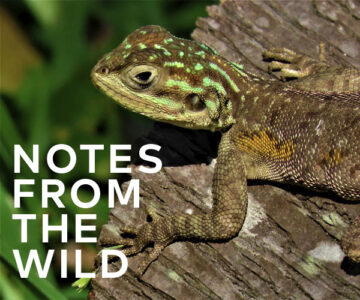In the Bleak Midwinter
Don Scallen explores how birds, mammals and reptiles have adapted to survive our long, trying winter.
The temperature along the Boyne River struggled to reach −10 C at midday. A wan sun illuminated the spires of spruce and cedar in the riverine landscape. Silence prevailed, broken occasionally by the croak of a distant raven or the chatter of foraging chickadees. Through boot-high snow, I struggled to follow the tracks of a white-tailed deer. Then a surprise. In the snow at my feet lay the body of a tiny bird. I knelt, picked it up and marvelled at its perfection. There was no evidence of injury, no discernible clue as to why it had died. The grey-green feathers were unruffled. A brilliant orange-yellow cap marked it as a golden-crowned kinglet, weighing less than a loonie. In Headwaters, only the hummingbird is smaller.
Golden-crowned kinglets are winter residents of these hills, and in a few areas where spruce trees prevail, they remain in spring to raise their families. They are likely unknown to most readers for a variety of reasons. These birds are thinly dispersed across the winter landscape, and their winter calls are so faint that many of us simply can’t hear them. Thus far I’ve been fortunate. Despite a lifetime of listening to rock and roll, I still can. Another reason we don’t often see them is that, unlike chickadees, woodpeckers and other overwintering birds, they ignore our bird feeders. Their tiny beaks are not designed to crack seeds.
This leaves kinglets reliant on insect fare, even in winter, and this dependence sets this diminutive songbird apart. Most insect-eating birds – the warblers, flycatchers, swifts and swallows – make haste for the South long before the first dusting of snow brightens the landscape. Others, such as nuthatches and chickadees, supplement scarce insect fare with seeds and offerings from our feeders. Woodpeckers also visit our feeders, of course, but get much of their food by hammering their stout beaks into wood, something kinglet beaks are ill-equipped to do.
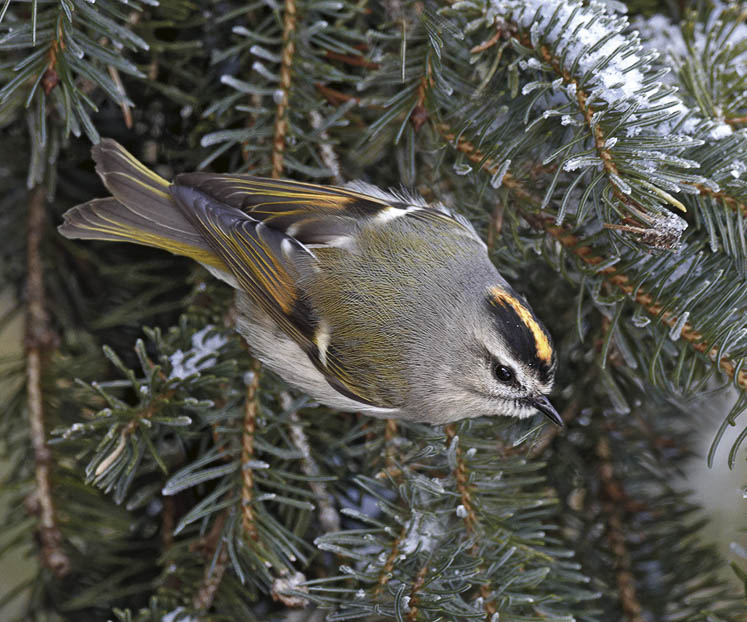
The beaks of golden-crowned kinglets are too small to crack seeds, so the birds are entirely reliant on insects for their sustenance – even in winter! Photography by Robert McCaw.
Bernd Heinrich, an American biologist, professor and unabashed fan of the golden-crowned kinglets living near his cabin in the Maine woods, committed himself to finding how they pulled off the seemingly impossible feat of surviving temperatures that routinely dropped to −30 C at night. One of his goals was to identify the food that fuelled kinglets in winter.
Heinrich’s methods will not sit well with many readers. He shot kinglets to examine their stomach contents. Regardless, he got his answer: the kinglet stomachs were packed with tiny moth caterpillars. Heinrich then searched for these dormant caterpillars himself and found them secured by silken strands to the branches of trees. Though his experimental approach may rankle, his discovery led him to conclude that “if you care about kinglets you need to care about moths.” Perhaps more broadly, he might have said, “If you care about kinglets, you need to care about the trees, the caterpillars and the moths that make their lives possible.”
Heinrich took a gentler approach toward uncovering another key to kinglet winter survival. He wondered how kinglets, even with full stomachs, survive long winter nights. Channelling the grit of his study subjects, Heinrich and his students slogged through snow drifts and dense forest in freezing temperatures at dusk to find the kinglets’ nighttime roosts. For years they came up empty.
Then Heinrich got lucky. He saw a small group of kinglets fly into a pine tree without emerging. Parting some boughs, he found them huddled side by side with their heads tucked into their breast feathers. The kinglets were keeping one another warm, just as we would if we were caught outdoors on a winter’s night with our companions.
So why did my kinglet die? Winter is harsh, even for creatures that have evolved ways to temper its severity. Heinrich reports that the mortality of golden-crowned kinglets averages more than 80 per cent annually! Most of this mortality occurs in winter despite the kinglets’ adaptations to the cold, a sobering reminder of how unforgiving the season can be. Thankfully, the kinglets that survive winter restore their numbers in the spring by raising eight or nine young.
Kinglets are not alone, of course, in facing the dual challenges of keeping warm and finding food in winter. These challenges must be met by all the animals that remain active during Ontario winters. But for some of our overwintering animals, the answer is to dampen their metabolisms and hunker down until spring. One of these animals is the humble painted turtle, resident of nearly every water body in our hills and a Herculean hibernator.
Anoxia and ectotherms
Like all reptiles and amphibians, painted turtles are ectotherms, which essentially means “outside heat.” The term cold-blooded, used more frequently, is imprecise – a painted turtle basking in 30 C weather will be far from cold-blooded.
Ectotherms assume the temperature of their surroundings. This means painted turtles must take shelter when temperatures fall in the autumn. They do this by digging into the mud on the bottom of wetlands. But though this behaviour protects them from freezing, it also seems to simply swap one death-dealing condition – freezing – for another: death by asphyxiation.
Anyone who lives in Headwaters knows our winters are long. In fact, the surfaces of our ponds can be frozen for four months or more, preventing atmospheric oxygen from mixing with the water. During that time, pond water can be depleted of dissolved oxygen. So how on earth do painted turtles survive?
When painted turtles enter hibernation, or brumation, a term used by biologists to describe winter dormancy in ectotherms, their metabolism grinds nearly to a halt. A heartbeat of about 40 times a minute in warm weather falls dramatically when painted turtles are settled comfortably in the mud. Some accounts report 10 beats a minute, others report only 10 beats an hour! Regardless, a diminished heart rate greatly reduces a turtle’s need for the oxygen that reacts with glucose (sugar) to create energy.
Hibernating painted turtles extract the precious gas from the water while they can, and their method of doing this bears mentioning. They absorb oxygen through the membranes of their cloaca or, more prosaically, their anus. But there comes a time in many ponds when the dissolved oxygen is completely gone – a condition called “anoxia.” Butt breathing no longer works. There is no oxygen to be had.
This anoxic condition would signal death for nearly all vertebrates. But painted turtles carry on for weeks or months without any oxygen at all. They still need some energy to run their reduced metabolisms, and to do this they use a substance called lactate, derived from glucose.
Other animals, including humans, also use this alternative energy pathway, which doesn’t need oxygen. Human runners, for example, supplement their energy production by using lactate when their laboured breaths can’t supply enough oxygen to keep up with their energy demands. The downside of lactate, however, is that too much can lead to debilitating levels of lactic acid. The legs of human runners burn in response to this acid, and their muscles weaken. Enough lactic acid can shut down vital organs. But painted turtles buffer this acid with calcium from their shells, much as we neutralize stomach acid with Tums and baking soda. This feat enables the turtles to do the seemingly impossible: survive without oxygen for months.
This is likely a major reason painted turtles are our most common turtle species. They can overwinter in almost any body of water, even stagnant ponds that are hostile habitats for some other turtle species.
Supercooling the blood
If adult painted turtles exhibit near superpower abilities to survive winter, so do their babies. Most painted turtle hatchlings remain in their nests over the winter. They become entombed in rock-hard frozen earth as they await the spring melt in March and April. If the temperature of their earthen chamber doesn’t fall too low – protracted periods of −8 C will kill them – their circulatory systems, powered by just one heartbeat a minute at 0 C, will continue to function, and they will survive.
This ability has been attributed to a natural antifreeze, such as glucose, in the hatchling turtle’s circulatory system. But in 2001, researchers at Colorado State University offered another explanation. They found that instead of relying on natural antifreeze, a hatchling painted turtle undergoes “supercooling,” which basically means its blood remains fluid despite dropping well below the freezing point.
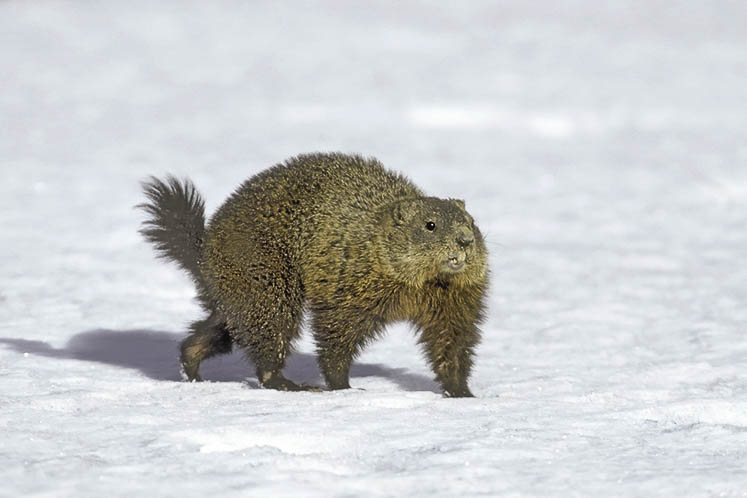
Woodchucks hibernate through the winter, waking up only occasionally for a privy run.
The mechanics of this astonishing feat are somewhat complicated. Water needs something to trigger the freezing process, so here’s a mouthful: “ice nucleating particle.” These particles, including dust, spores and pollen, are necessary for ice to form, though vibrations can also play a role. These particles are largely absent in the bodies of hatchling painted turtles, and the turtles lie in a quiet, vibration-free environment. This means ice can’t form. Temperatures can drop far below zero and fluids will remain liquid – in a supercooled state. The little hearts of the painted turtles continue to beat, albeit very slowly, pumping supercooled blood through their bodies.
Pumping up glucose levels
Though painted turtle hatchlings may not use antifreeze to keep their vital tissues from freezing, some frogs do. One of them is the wood frog, the species we hear “quacking” in early spring.
Wood frogs are found farther north than any other amphibian in North America. Their range extends beyond the Arctic Circle. Near Inuvik in the Northwest Territories, wood frogs routinely survive January temperatures that average −22 C during the day and −29 C at night. And yet they don’t bury themselves or dive into mud at the bottom of wetlands. They simply hide under leaves on the forest floor.
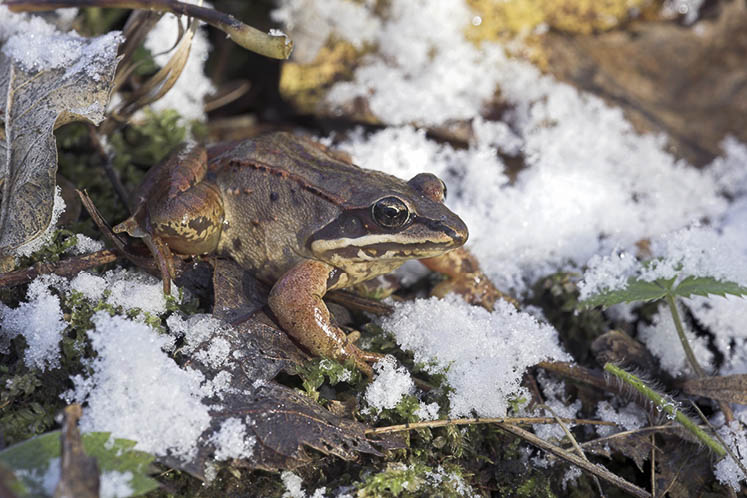
Wood frogs hide under leaf litter, unmoving but kept alive by “antifreeze” in their organs.
First, ice forms in their body cavities, surrounding their vital organs and cells. But those organs and cells don’t freeze because they are full of glucose, the same glucose that circulates in human blood. The frogs produce this sugar in prodigious quantities and flood their cells with it, inhibiting the formation of ice within. Their blood sugar levels skyrocket to as high as 100 times normal, an increase that would be lethal for humans.
Because sugar-infused wood frogs can survive in leaf litter on the forest floor, they are reanimated by the spring sun, while frogs hibernating underwater are still deep in slumber. This enables wood frogs to make their way early to their breeding sites in vernal pools, a crucial survival strategy because vernal pools are ephemeral and dry up later in the spring. The tadpoles have only a limited window to grow and change into froglets before this happens.
Pond-hibernating frogs include bullfrogs, green frogs and leopard frogs. Some of these, facing the same anaerobic conditions as painted turtles, perish if the ice cover is prolonged. After a late ice-out, I’ve found dead leopard frogs floating in the large kettle pond at Forks of the Credit Provincial Park.
Adapting to snow cover
Like frogs and turtles, some Headwaters mammals hibernate through the winter. These include chipmunks, woodchucks and jumping mice. Chipmunks waken periodically, rub their eyes, and see what they can find to eat in an underground larder stocked with food gathered in the fall. Woodchucks and jumping mice, however, rely on layers of body fat accumulated during feverish bouts of feeding before hibernation. They occasionally wake up to use the privy, but that’s about it.
But in this area, most mammals remain active through the winter. Hiking the Bruce Trail in Caledon one November afternoon, a friend and I came upon a snowshoe hare that was moulting. Much of its brown fur had been shed and replaced by winter white. Snowshoe hares, along with long-tailed and short-tailed weasels in Headwaters, go through twice yearly moults that render them white in winter and brown in summer.
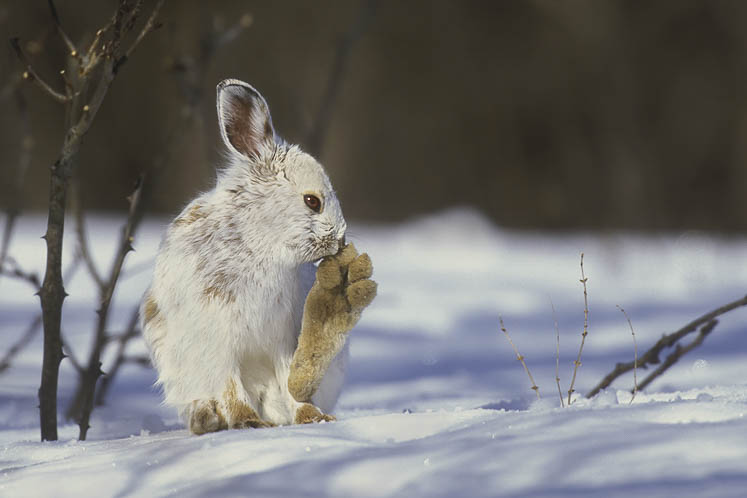
Snowshoe hares turn white in winter to camouflage against the snow.
This colour change, governed by temperature change, cloaks these animals with seasonal camouflage that helps protect them from predators. This strategy works – if the weather co-operates. The largely white snowshoe hare we saw that November afternoon stood out like a beacon on a snowless landscape, shouting “Here I am!” to predators such as hawks.
Snow has shaped the evolution of snowshoe hares and short-tailed weasels and, in fact, dictates where they live in North America. They can survive only in areas of reliable winter snow cover. Long-tailed weasels, however, can range much farther south because their evolutionary alchemy enables them to remain brown in areas that are largely snowless.
Snow also plays a significant role in the lives of other Headwaters animals. Ruffed grouse dive into it to pass cold winter nights, snug in cavities formed by their body heat. And they have the option of remaining under the snow should a winter storm be raging above.
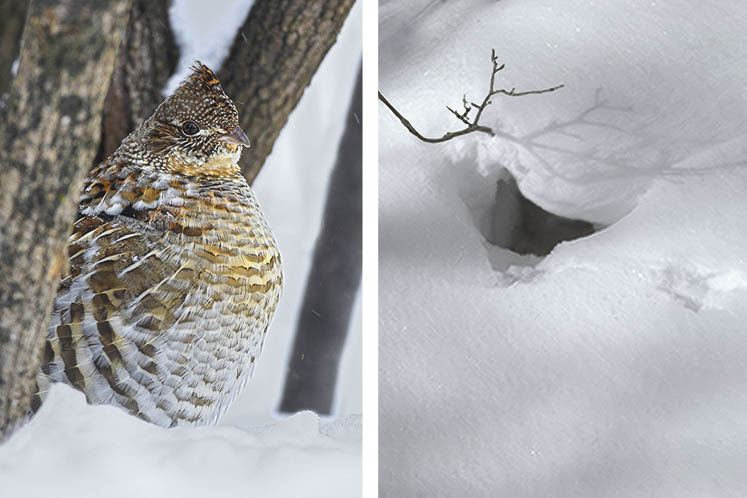
Ruffed grouse remain active during the winter months, but hide away from storm and cold of night beneath the snow in cavities formed by their body heat.
Snow cover also creates a temporary ecosystem called the “subnivean zone,” the area between the surface of the snow and the ground. Temperatures approaching 0 C can prevail in this zone, even if surface temperatures are well below freezing. Small mammals such as mice, voles and shrews flourish in the warmth of the subnivean zone and enjoy some safety from predators under the snow’s protective cover.
In nature, though, no protection is absolute. Owls hunt in Headwaters year-round. Faces shaped like satellite dishes direct the sound of the tiny footfalls of mice to this bird’s offset ears. This means each ear receives sound at a slightly different time, allowing the owls to precisely detect the location of prey, whether in the open or concealed under snow. They launch themselves on silent wings, thrust their talons into the snow and often rise with a struggling rodent in their grasp.
The finely tuned hearing of owls is a marvel, but red foxes may be endowed with an astonishing sense that owls don’t have – one that enables foxes to be very effective hunters of animals in the subnivean zone. These canids leap into the air to pounce on mice they hear under the snow, in a hunting technique fittingly called “mousing.”
The amazing aspect of this mousing is the possibility it may be assisted by an internal compass. Foxes in a Czech study were found to align most of their jumps northeasterly toward magnetic north. The mechanics of how this helps foxes target prey is complicated, but it seems to work. The foxes had far greater success catching mice when they jumped in a northeasterly direction.
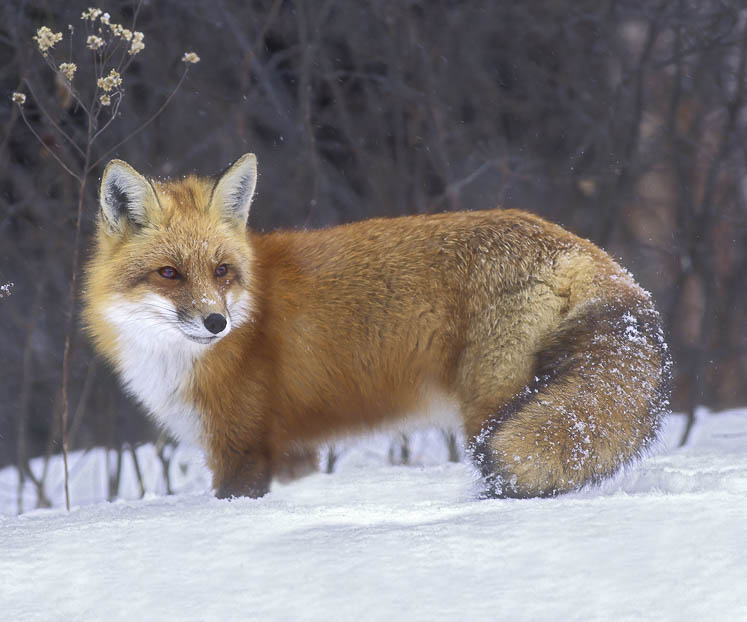
The sharp ears of red foxes may be assisted by a “compass” that allows them to successfully detect the location of mice under the snow.
Last winter I hiked the Mizzy Lake trail in Algonquin Provincial Park and was delighted when a pair of Canada jays found me. I rummaged in my backpack for my lunch and ended up sharing much of my ham sandwich with the jays. The Royal Canadian Geographic Society has endorsed this jay as Canada’s national bird, but the federal government has yet to move on the recommendation.
Why Canada’s national bird? Canada jays are present in every province and territory, and if offered tasty tidbits, they are charming, trusting animals that readily land on the outstretched hands of besotted human beings. Alas, they are not found in these hills, however, and though you may find this hard to believe as January blizzards rattle your windowpanes, this is likely because winters here are too warm.
It’s all about refrigeration. The ham and bread these jays persuaded me to part with was not eaten immediately. Rather, the jays took the morsels, flew off a short distance and soon returned for more booty. The food these jays gather, if more than they need immediately, is cached – glued with sticky saliva to clefts of tree bark for later retrieval. This is one reason Canada jays are so successful across Canada’s North.
The jays’ food caching ensures a ready supply of calories through the long winters. But there’s a problem, one that may explain why Canada jays do not live in Headwaters. Much of the food they store, like my ham and bread, and like berries and bits of meat scavenged from the carcasses of deer and moose, is perishable. This isn’t a problem where winters are reliably cold, keeping the food refrigerated until required. But where winters see-saw between freeze and thaw, as they often do here, much of this food spoils.
With warming winters, Algonquin Park is no longer immune to these stark temperature changes, and this appears to be hurting the Canada jays that live there. Dan Strickland, a former Algonquin Park naturalist, has studied Canada jays for decades. His research has revealed a steady decline in their numbers as winters in the park have been getting warmer. Along with moose and wolves, Canada jays are among the most celebrated Algonquin animals, but they may eventually disappear from the park.
Here in Headwaters, blue jays, like their Canada jay kin, also cache food, but usually less perishable items such as acorns. A blue jay might hide 3,000 acorns throughout its territory in the autumn and successfully relocate most of them days or weeks later. But jays and other caching animals still sometimes forget where things are, just as we forget where we put our car keys. And while a forgetful blue jay may miss a meal, the forgotten acorn can grow into a tree, a win for the oak tribe but also, ultimately, for future jays that will harvest acorns from that tree when it matures.
I’ve only scratched the surface of the remarkable ways our birds and animals survive winter. Many other stories could be told, and no doubt biologists like Bernd Heinrich will continue to discover new and wonderful ways animals cope with this unforgiving season.
But for most of us, it is enough to pause and marvel at the tenacity of our local wildlife. We stay alive in winter with fireplaces and furnaces, warm clothing and regular visits to supermarkets. Our wild companions don’t need any of these artificial assists. Instead, they tap a stunningly diverse array of survival strategies to endure, and sometimes even thrive, in the season of snow.
Related Stories
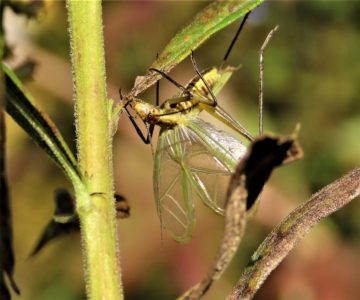
Crooning Tree Crickets
Nov 3, 2022 | | Notes from the WildMale tree crickets – rock stars of the insect realm – sing to attract females, and display other courtship behaviour not so different from ours.
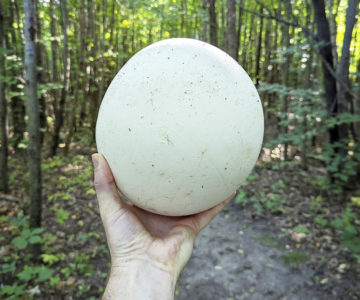
Fascinating Fungi
Oct 5, 2022 | | Notes from the WildFall is the perfect time to get down low and take a closer peek at the stunningly diverse and complex organisms that are fungi

